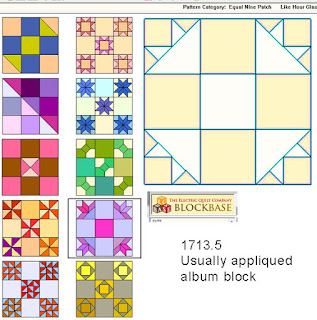Block 5: Cross and Crown by Denniele Bohannon
Our fifth Antebellum Album block is a version of a pattern we might call Bear's Paw or Goose Tracks. This month's focus is a Massachusetts public school.
Charlotte Louise Bridges Forten (1837-1914)
perhaps the 1870s.
Like many 19th-century girls looking for an education, sixteen-year-old Lottie Forten left home to board with family friends while attending a girls' school as a day student. She'd grown
up in Philadelphia where her father considered the available schools second
rate. The only available schools for the Fortens were segregated colored schools. Free black Thomas Forten refused to send his daughter to a second-rate school.
Essex Street, Salem, about 1870
Another opportunity appeared in 1853. Lottie was invited to Salem, Massachusetts, which prided
itself on a colonial tradition of free public schools. Nearly ten years earlier Salem
became the first city in Massachusetts to integrate those schools after a
boycott of the "inferior" separate school by black parents. Lottie boarded with the Remond family, activists in the desegregation battle.
In 1818 Sarah Ann Pollard, a student at Salem's
Clarrisa Lawrence School for African-American girls,
stitched this sampler now in the collection of Colonial Williamsburg.
Salem schools may have been Integrated by law but Lottie was
the only pupil of color in the Higginson Grammar School for Girls. Her diary details
the emotional ups and downs of a shy, self-disciplined but self-deprecating
teenager who was periodically bed ridden with "lung fever."
Although many of Higginson's 200 students were undoubtedly unkind (Lottie marveled that "every colored person is not a misanthrope") she made good friends such as Sarah Brown (Brownie) who kept in touch through letters after leaving Salem. Fitting in was difficult but Lottie benefited from principal Mary Lakeman Sheperd's attention and mentoring. Mary Sheperd, about 12 years older than her star student, also remained a lifelong friend.
Charlotte traveled from Philadelphia north to to Salem
to find a good school
Although many of Higginson's 200 students were undoubtedly unkind (Lottie marveled that "every colored person is not a misanthrope") she made good friends such as Sarah Brown (Brownie) who kept in touch through letters after leaving Salem. Fitting in was difficult but Lottie benefited from principal Mary Lakeman Sheperd's attention and mentoring. Mary Sheperd, about 12 years older than her star student, also remained a lifelong friend.
Charlotte graduated from Salem Normal School
(teachers' college) in 1856.
Cross and Crown by Becky Brown
The Block
Cross and Crown seems a good block for Charlotte who was cursed or blessed by always being "first".
"Miranda B Ervine/California"
More likely from California, Pennsylvania, in Pittsburgh
rather than the more famous west coast state.
The block was quite popular for early friendship quilts.
Quilt dated 1842 - 1848, Caroline Bradley Magruder.
Documented in the Maryland project and in their book
A Maryland Album: Quiltmaking Traditions, 1644-1934
In the 1840s and '50s these nine patches were usually appliqued rather than pieced. In the example below the quiltmaker began with white corner squares and appliqued 2 green triangles and one green square on top of the white.
"David Raber
Lebanon, Pa
January 12, 1848"
Applique stitches.
You'd start with a pieced pink nine-patch and add the red applique pieces.
But we are not doing applique this year!
Cross and Crown By Denniele Bohannon
More about that pattern here:
The pieced design based on equal size nine-patch squares
is not in BlockBase or my Encyclopedia of Pieced Quilt Patterns
because it wasn't published in this proportion. It should be on this page.
I'm writing it in my copy as #1713.5.
A pieced block of different proportions.
Appliqued blocks tend to be equal nine patches
while the pieced version have narrower center strips.
Cutting a 12" Finished, Pieced Block
A - Cut 4 dark squares 2-1/2".
B - Cut 2 dark and 2 light squares 3-1/4". Cut each in half diagonally to make 2 triangles.
You need 8 light triangles and 8 dark.
C - Cut 4 dark and 1 light squares 4-1/2". This is a correction.
D - Cut 2 light squares 4-7/8". Cut each in half diagonally to make 2 triangles. You need 4.
Cross and Crown by Pat Styring
The Civil War & After
Charlotte spent some of her Civil War on St. Helena Island in Beaufort County, South Carolina, where she continued her diary. She taught freed slaves for two years until her health required she return North.
The Penn School on St. Helen Island founded in 1862.
Northern teachers volunteered to maintain
schools on Union-occupied territory during the war.
After the war she worked for the Treasury Department in Washington and married Reverend Francis J. Grimké. She died in 1914, praised as an exemplary minister’s wife and a poet, writer and lecturer in her own right.
By Mark Lauer
Sentiment for May
This little flourish, full of good wishes, resembles
a Union shield so would make an appropriate Union sentiment.
Southern segregated school after the war
Charlotte Forten Grimke’s diaries have been published in several forms. The most comprehensive is edited by Brenda Stevenson: Journals of Charlotte L. Forten Grimke (Schomberg Library of Nineteenth-Century Black Women Writers. Oxford University Press, 1998.)
See a preview here:
Cross and Crown by Mark Lauer
1842 - 1844 from the Rieff family and others, Pennsylvania
Collection of Gail Bakkom.
Quilt Index Signature Project
I show an album sampler each month with the monthly pattern in it but I cannot find this block in a sampler. Apparently it was most often used for repeat block signature quilts.
For those of you who want to plan ahead: Buy the PDF's for patterns 5-8 on Etsy.
Or I'll mail you a black & white copy.






























































